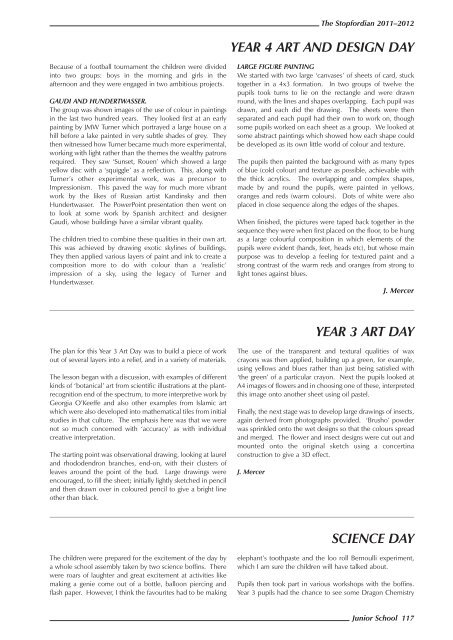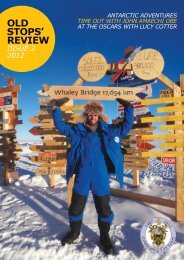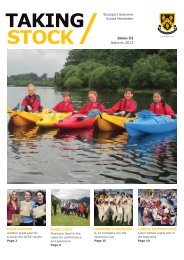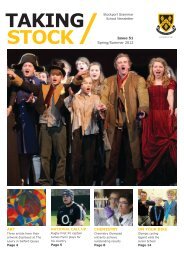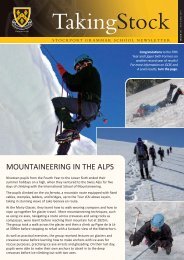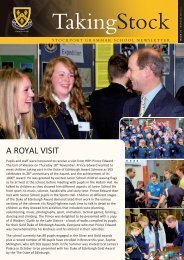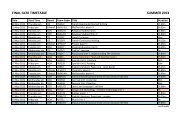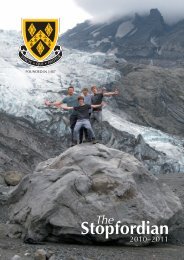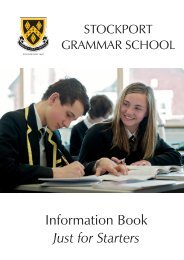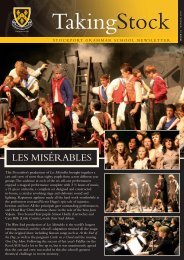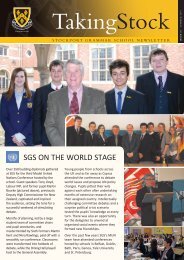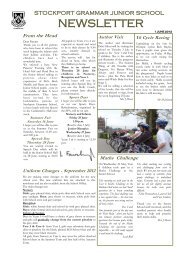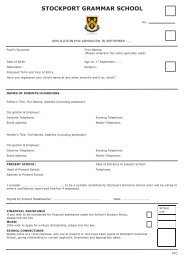Download the 2011-2012 Stopfordian (pdf) - Stockport Grammar ...
Download the 2011-2012 Stopfordian (pdf) - Stockport Grammar ...
Download the 2011-2012 Stopfordian (pdf) - Stockport Grammar ...
Create successful ePaper yourself
Turn your PDF publications into a flip-book with our unique Google optimized e-Paper software.
The <strong>Stopfordian</strong> <strong>2011</strong>–<strong>2012</strong><br />
YEAR 4 ART AND DESIGN DAY<br />
Because of a football tournament <strong>the</strong> children were divided<br />
into two groups: boys in <strong>the</strong> morning and girls in <strong>the</strong><br />
afternoon and <strong>the</strong>y were engaged in two ambitious projects.<br />
GAUDI AND HUNDERTWASSER.<br />
The group was shown images of <strong>the</strong> use of colour in paintings<br />
in <strong>the</strong> last two hundred years. They looked first at an early<br />
painting by JMW Turner which portrayed a large house on a<br />
hill before a lake painted in very subtle shades of grey. They<br />
<strong>the</strong>n witnessed how Turner became much more experimental,<br />
working with light ra<strong>the</strong>r than <strong>the</strong> <strong>the</strong>mes <strong>the</strong> wealthy patrons<br />
required. They saw ‘Sunset, Rouen’ which showed a large<br />
yellow disc with a ‘squiggle’ as a reflection. This, along with<br />
Turner’s o<strong>the</strong>r experimental work, was a precursor to<br />
Impressionism. This paved <strong>the</strong> way for much more vibrant<br />
work by <strong>the</strong> likes of Russian artist Kandinsky and <strong>the</strong>n<br />
Hundertwasser. The PowerPoint presentation <strong>the</strong>n went on<br />
to look at some work by Spanish architect and designer<br />
Gaudi, whose buildings have a similar vibrant quality.<br />
The children tried to combine <strong>the</strong>se qualities in <strong>the</strong>ir own art.<br />
This was achieved by drawing exotic skylines of buildings.<br />
They <strong>the</strong>n applied various layers of paint and ink to create a<br />
composition more to do with colour than a ‘realistic’<br />
impression of a sky, using <strong>the</strong> legacy of Turner and<br />
Hundertwasser.<br />
LARGE FIGURE PAINTING<br />
We started with two large ‘canvases’ of sheets of card, stuck<br />
toge<strong>the</strong>r in a 4x3 formation. In two groups of twelve <strong>the</strong><br />
pupils took turns to lie on <strong>the</strong> rectangle and were drawn<br />
round, with <strong>the</strong> lines and shapes overlapping. Each pupil was<br />
drawn, and each did <strong>the</strong> drawing. The sheets were <strong>the</strong>n<br />
separated and each pupil had <strong>the</strong>ir own to work on, though<br />
some pupils worked on each sheet as a group. We looked at<br />
some abstract paintings which showed how each shape could<br />
be developed as its own little world of colour and texture.<br />
The pupils <strong>the</strong>n painted <strong>the</strong> background with as many types<br />
of blue (cold colour) and texture as possible, achievable with<br />
<strong>the</strong> thick acrylics. The overlapping and complex shapes,<br />
made by and round <strong>the</strong> pupils, were painted in yellows,<br />
oranges and reds (warm colours). Dots of white were also<br />
placed in close sequence along <strong>the</strong> edges of <strong>the</strong> shapes.<br />
When finished, <strong>the</strong> pictures were taped back toge<strong>the</strong>r in <strong>the</strong><br />
sequence <strong>the</strong>y were when first placed on <strong>the</strong> floor, to be hung<br />
as a large colourful composition in which elements of <strong>the</strong><br />
pupils were evident (hands, feet, heads etc), but whose main<br />
purpose was to develop a feeling for textured paint and a<br />
strong contrast of <strong>the</strong> warm reds and oranges from strong to<br />
light tones against blues.<br />
J. Mercer<br />
YEAR 3 ART DAY<br />
The plan for this Year 3 Art Day was to build a piece of work<br />
out of several layers into a relief, and in a variety of materials.<br />
The lesson began with a discussion, with examples of different<br />
kinds of ‘botanical’ art from scientific illustrations at <strong>the</strong> plantrecognition<br />
end of <strong>the</strong> spectrum, to more interpretive work by<br />
Georgia O’Keeffe and also o<strong>the</strong>r examples from Islamic art<br />
which were also developed into ma<strong>the</strong>matical tiles from initial<br />
studies in that culture. The emphasis here was that we were<br />
not so much concerned with ‘accuracy’ as with individual<br />
creative interpretation.<br />
The starting point was observational drawing, looking at laurel<br />
and rhododendron branches, end-on, with <strong>the</strong>ir clusters of<br />
leaves around <strong>the</strong> point of <strong>the</strong> bud. Large drawings were<br />
encouraged, to fill <strong>the</strong> sheet; initially lightly sketched in pencil<br />
and <strong>the</strong>n drawn over in coloured pencil to give a bright line<br />
o<strong>the</strong>r than black.<br />
The use of <strong>the</strong> transparent and textural qualities of wax<br />
crayons was <strong>the</strong>n applied, building up a green, for example,<br />
using yellows and blues ra<strong>the</strong>r than just being satisfied with<br />
‘<strong>the</strong> green’ of a particular crayon. Next <strong>the</strong> pupils looked at<br />
A4 images of flowers and in choosing one of <strong>the</strong>se, interpreted<br />
this image onto ano<strong>the</strong>r sheet using oil pastel.<br />
Finally, <strong>the</strong> next stage was to develop large drawings of insects,<br />
again derived from photographs provided. ‘Brusho’ powder<br />
was sprinkled onto <strong>the</strong> wet designs so that <strong>the</strong> colours spread<br />
and merged. The flower and insect designs were cut out and<br />
mounted onto <strong>the</strong> original sketch using a concertina<br />
construction to give a 3D effect.<br />
J. Mercer<br />
SCIENCE DAY<br />
The children were prepared for <strong>the</strong> excitement of <strong>the</strong> day by<br />
a whole school assembly taken by two science boffins. There<br />
were roars of laughter and great excitement at activities like<br />
making a genie come out of a bottle, balloon piercing and<br />
flash paper. However, I think <strong>the</strong> favourites had to be making<br />
elephant’s toothpaste and <strong>the</strong> loo roll Bernoulli experiment,<br />
which I am sure <strong>the</strong> children will have talked about.<br />
Pupils <strong>the</strong>n took part in various workshops with <strong>the</strong> boffins.<br />
Year 3 pupils had <strong>the</strong> chance to see some Dragon Chemistry<br />
Junior School 117


